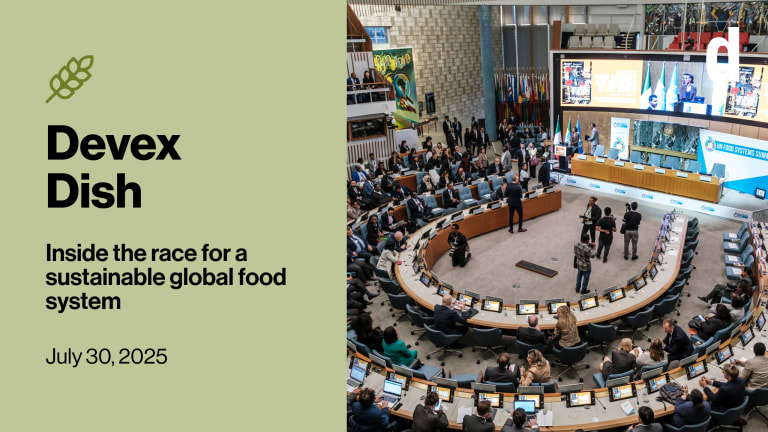
This is a preview of Devex Dish
Sign up to this newsletter to get the inside track on how agriculture, nutrition, sustainability, and more are intersecting to remake the global food system in this weekly newsletter.
Greetings from Port-au-Prince, Haiti. I’m here this week looking into the state of the country’s food system after an extremely difficult year. Haiti was dealing with widespread insecurity even before the July assassination of President Jovenel Moïse. Then a 7.2 magnitude earthquake hit its southern peninsula in August, followed shortly by Tropical Storm Grace.
Unfortunately, Haiti isn’t new to addressing the fallout from compounding challenges. A central theme to my conversations here is the country’s ongoing instability — the uncertainty surrounding the political situation, an economy affected by inflation, and transportation struggles caused by unpredictable strikes and protests that can make it nearly impossible to move goods to where they need to be.
All of these factors make it challenging for a local market to thrive, which means most food is imported — hiking prices out of reach for many. A recent government assessment found that 4.3 million people in the country are food insecure — up 300,000 from last year. There’s also a fuel shortage, compounded by security issues at ports. Power routinely flickers out, sometimes for just a moment, and sometimes for longer — and no one even blinks, demonstrating how used to faulty basic services the population has become.
I’m heading next to Les Cayes, in the region affected by the August earthquake, to see how the food system there is coping nearly two months after the disaster. Stay tuned here at Devex Dish for my reporting from the ground over the next few weeks.
Is the food system where you live complicated by external factors such as instability or inflation? Let me know what you observe in your community by writing to me at dish@devex.com.
A temporary fix
The food insecurity crisis in Yemen has temporarily slowed down. But David Gressly, the top United Nations official in the country, tells me that sustained funding is needed to keep people out of famine.
“We’ve stopped the move towards famine temporarily, but I emphasize the last word because temporary is fragile and needs to be sustained,” Gressly said when we sat down for an interview in Washington last week.
At the beginning of this year, roughly 50,000 people in Yemen were experiencing famine, known as IPC 5 in the classification system that ranks levels of food insecurity. Five million people were in IPC 4 — or “emergency” — and an additional 11 million were in IPC 3 — or “crisis.” The U.N. is currently reaching about 13 million people in the country with food assistance.
Read: Sustained donor support required to keep famine at bay in Yemen

Pricey peas
An “unprecedented” shortage of peas caused by a severe drought in Canada has led to prices of the tiny legumes more than doubling. A French supplier warns that plant-based meat producers that use peas as an ingredient will feel the pinch as low yields in Europe further affect pea availability, according to the Financial Times.
Fun fact: Peas are the fastest growing category of plant-based protein used by food companies.
A triple threat
Going into COP 26, the world must recognize the “triple challenge” humanity faces, says Joao Campari, who led the U.N. Food Systems Summit’s third “action track” on boosting “nature-positive production.”
“[This is a] plea for everyone to connect the food, climate, and nature agendas because sometimes we tend to forget this,” Campari says. “The food system is responsible for about 70% of the biodiversity loss on land and 50% on freshwater. The food system is responsible for … between 29% and 33% of global greenhouse gas emissions.”
Read: Why food systems transformation must be linked to the climate fight
Number munching
10%
-Last month, UN Women published a report about progress on the SDGs that contained more bad news, I’m afraid. The report found that the COVID-19 pandemic has tested and, in some cases, reversed progress on expanding women’s rights and opportunities. Women’s food insecurity levels were 10% higher than men’s in 2020, up from 6% in 2019.
A mouthful
“Yet, in this time of looming famine and heartbreaking need, the Government of Ethiopia continues to take steps to prevent aid from reaching the people who need it, instead of doing everything in its power to facilitate the delivery of life-saving assistance to its citizens.”
— Samantha Power, administrator, USAIDPower condemned Ethiopia’s expulsion of U.N. officials from the country last week and called on the government to reverse the decision, saying, “This action is absolutely unacceptable,” as it “undermines international efforts to deliver humanitarian assistance” to the millions of Ethiopians who need it.
+ ICYMI: Ethiopia suspends MSF and NRC over ‘dangerous’ accusations
Take a bite
Researchers in Kenya are using “bee fences” to deter elephants from farming land. [Scientific American]
Researchers have identified more than 80 distinct “foodscape” classes, or distinct food production geographies. [The Nature Conservancy]
FAO says starvation and hunger-related deaths are a reality amid worsening food crises. [FAO]
Rumbi Chakamba contributed to this edition of Devex Dish.









